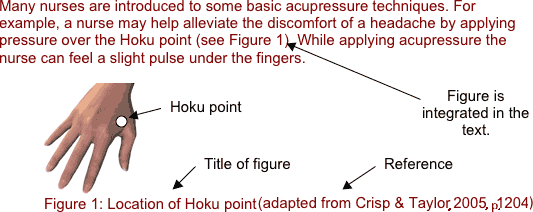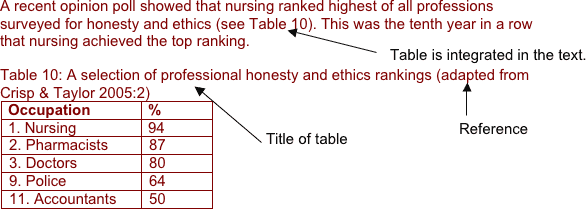Previous page
Task A: Avoiding plagiarismNext page
Task C: Citing several sources at onceIndex page
Workshops indexTask B: Citing authorities in your text
Summary
The School of Health uses the APA system of referencing, where the author’s surname and date of publication are inserted in the text. UNE referencing explains how to reference using this style. If you use the work of others (e.g. ideas, words, figures, tables, drawings, photographs, graphics) in your writing, then you must reference the source in the text of your assignment. This task introduces you to some basic referencing conventions.
You will learn:
Using in-text references
The person who marks your assignment should be able to find and check all your sources of information. Providing details about your sources of information in your writing is called in-text referencing.
You must use in-text references for direct quotations, paraphrases/summaries and secondary references. You also need to understand how to use author orientation.
Direct quotations
You are using direct quotations when you copy the exact words of the author. There are two types of direct quotations:
- Short quotations are less than 40 words. The conventions you must follow for using short quotations are:
- use single quotation marks
- flow with the text of the sentence
- Long/block quotations are more than 40 words. The conventions you must follow for using long quotations are:
- indent to the right
- use single spacing, where the rest of your essay may be double spaced
- generally, introduce the quotation with a colon (other options may apply)
- begin with a capital letter (other options may apply)
Please note that you do not use quotation marks for block quotations.
Example: It has been suggested that spirituality is "an important factor that helps to achieve the balance needed in maintaining health and wellbeing and in coping with illness" (Crisp & Taylor, 2005, p. 536).
Example: The significance of spirituality for health and healing was discussed by Crisp and Taylor (2005, p. 536):
Recently, nurse researchers, pastoral care professionals, doctors, social workers and others have proposed that spirituality has special importance as the integrating theme that unifies all aspects of a person's health. … It is a force intrinsic to human nature and is one of the deepest and most potent resources for healing.
Paraphrases and summaries
You are paraphrasing and summarising when you use your own words to express the ideas and opinions of other writers. Paraphrases and summaries must be referenced using the APA referencing system.
Secondary references
You are using secondary references when you refer to the work of an author you have NOT read who has been cited in the work of another author you HAVE read (e.g. authors referred to in your textbooks). As you have not read the author's work, you must acknowledge this by using a secondary reference. You need to add 'cited in' to your reference.
Example: (Moberg, 2001, as cited in Crisp & Taylor, 2005, p. 537)
Author orientation
When you write an in-text reference you must give the name of the author/s. There are two ways you can place the name of the author/s in your writing:
- Strong author orientation is when you put the name of the author/s at the beginning of your information, followed by the date and page in brackets and an appropriate verb.
Example: Crisp and Taylor (2005, p. 172) proposed that a knowledge of developmental theory assists nurses to employ critical thinking skills in understanding behaviour. - Weak author orientation is when you put the name of the author/s, date and page in brackets at the end of
your information.
Example: A knowledge of developmental theory can assist nurses to employ critical thinking skills in understanding behaviour (Crisp & Taylor, 2005, p. 172).
Activity
Here is a section of writing quoted directly from a nursing text.
Education such as prenatal classes can prepare pregnant women, their partners, and other support people to participate in the birthing process. Social support has also been reported to have a positive impact on pregnant women and their families. Schaffer and Lia-Hoagberg (1997) reported that social support positively affected both the adequacy of prenatal care and prenatal health behaviours.
(The excerpt is from Crisp, J. & Taylor, C. (2005), Potter and Perry's Fundamentals of Nursing, (2nd ed;) Sydney, Aust.: Elsevier, p. 230.)
Following are 4 different ways of using information from the above excerpt in your writing. Select the type of in-text reference that has been used in each example.
Example 1
Education and social support play a significant positive role during the prenatal period for pregnant women and their significant others (Crisp & Taylor, 2005, p. 230).
Example 2
Two significant influences during the prenatal period have been identified (Crisp & Taylor, 2005, p. 230):
Education such as prenatal classes can prepare pregnant women, their partners, and other support people to participate in the birthing process. Social support has also been reported to have a positive impact on pregnant women and their families.
Example 3
Social support has a positive influence on pregnant women's prenatal care and health behaviours (Schaffer & Lia-Hoagberg, 1997, as cited in Crisp & Taylor, 2005, p. 230).
Example 4
It has been suggested that attending prenatal classes 'can prepare pregnant women, their partners, and other support people to participate in the birthing process' (Crisp & Taylor, 2005, p. 230).
Now select the type of author orientation that has been used in the following two examples.
Example 5
Crisp and Taylor (2005, p. 230) discussed the importance of education and social support for pregnant women and their significant others during the prenatal period.
Example 6
Education and social support play a significant positive role during the prenatal period for pregnant women and their significant others (Crisp & Taylor, 2005, p. 230).
More info
- APA referencing (UNE)
- Using quotes - the APA system (UNE)
- Avoiding plagiarism (UNE) (Exercise on page 2: Check your understanding of plagiarism)
How to use tables and figures in your text
In some units, you can insert tables and figures (diagrams, graphs, photographs, etc) in your assignment tasks, but you must first check your unit notes or ask your unit coordinator to find out if it is acceptable. The sources of all tables and figures must be acknowledged unless they are entirely from your own work. Tables and figures follow the APA referencing conventions.
At times, subject matter is most clearly presented in a table or other pictorial form. When tables or figures are used, it is essential that they are correctly integrated within the text, titled, referenced and placed as near as possible in the text to where they are first mentioned.
Example 1: Inserting a figure

Example 2: Inserting a table

Now that you know the basics of how to use tables and figures in your text, here is a list of the conventions that you must follow:
- Every table or figure (including those in the appendix) must be referred to in text before you insert it.
- Tables and figures should be placed as near as possible in the text to where they are first mentioned. This is usually at the end of the paragraph.
- The title for a table goes ABOVE the table.
- The title for a figure goes BELOW the figure.
- All titles of tables and figures must be followed by the appropriate reference.
- If you have changed the figure or table in some way or only used part of the information: (i) you may give it your own title or use the original title; (ii) the reference must begin with 'adapted from'.
- There should be two numbering series, one for figures and one for tables. All figures and tables are numbered according to your own work (e.g. the second figure in your assignment becomes 'Figure 2').
- Large and complex illustrations may be best placed in an appendix. Tables and figures in appendices are numbered according to the appendix number (e.g. Appendix 1 Figure 1).


